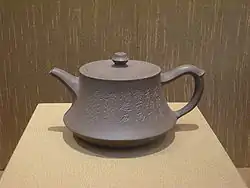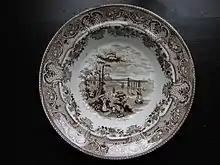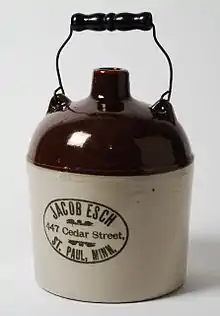炻器
炻器(shí,英语:Stoneware)是介于陶器与瓷器之间的陶瓷器[1],原料主要是石器土或非耐火的火泥[2],吸水率通常小于6%[3],有的施釉,有的不施釉[4]。


名称
炻器这个名称来源于欧洲,本意是石器。日本人翻译时为了表明它不是用石头加工成的,而是经过烧制的,所以加上‘火’字旁,写作炻器。中国传统上没有炻器这一分类,例如定窑烧制的炻器被称为瓷器[5]。根据欧洲工业标准Combined Nomenclature:
- "炻器,这虽然密集,不可渗透和硬足以抵抗刮过钢点,不同于 瓷器 ,因为它是更加 不透明的,并通常只部分 陶瓷中。 它可能是玻璃质或半玻璃体。 它通常是色灰色和褐色,因为杂质在土用于其制造的,通常是玻璃。"
种类

炻器按其坯体的细密性,均匀性以及粗糙程度可将炻器分为粗炻器与细炻器两大类。粗炻器常见于工业用的耐酸化工陶瓷[7],建筑陶瓷和缸器,细炻器常见于日用炻器和陈设品。[8]
炻器在公元前2600至前1900年印度河流域文明时期被大量烧制[9][10][11]中国在晚商时期出现炻器[12],在汉代大量生产[13][14]。宜兴紫砂陶即是一种不施釉的有色细炻器。
欧洲炻器有:
材料和烧制
炻器土坯常含有铁或碳等杂质,可塑性差异很大[23]。耐火火泥中高岭石含量高,并有少量的云母和石英。非耐火的火泥主要是云母和长石。[24]
炻器坯料的化学成分变化范围大致为:SiO2 55~65%;Al2O3 25~35℃;熔剂氧化物总量5~8%。[25]
瓷器烧制温度从1100 °C至1300 °C不等[26]。
炻器的吸水率可以低于1%。[27]
另一个类型,Flintless石器、也已确定。 它被定义,在英国陶(卫生和福利)的特殊规定的1950为:"石器、身体,其中包括自然粘土没有 火石 或 石英 或其他形式的免费的 二氧化硅 已被添加。"[28]
传统 东亚 只有思想进行分类陶器进入"低发射"和"高发射"产品,等同于陶器和瓷器、不间欧洲的类的石器、以及众多的当地类型的石制主要是认为这是瓷器,但往往没有白色的和透明。[29]
参见
参考文献
- Clay vitrifying temperatures
- Standard Terminology of Ceramic Whiteware and Related Products: ASTM Standard C242.
- Arthur Dodd & David Murfin.
- Encyclopædia Britannica Jasperware is unglazed stoneware
- Valenstein, S. (1998).
- . MNHS Collections. [2017-05-19]. (原始内容存档于2012-04-03).
- Dictionary Of Ceramics.
- F. Singer & S. S. Singer.
- Mark Kenoyer, Jonathan. . Oxford University Press. 1998: 260.
- Satyawadi, Sudha. . D.K. Printworld. July 1, 1994: 324. ISBN 978-8124600306.
- Blackman et all. . Madison, WI, USA: Prehistory Press. 1992: 37–44.
- Sato, Masahiko.
- Li, He. Chinese Ceramics: A New Comprehensive Survey.
- Rhodes, Daniel.
- The Discovery Of European Porcelain By Bottger - A Systematic Creative Development.
- 300th Anniversary.
- Invention Of European Porcelain.
- . Wedgwood.com. [2012-04-26]. (原始内容存档于2010-08-03).
- . Wedgwoodsocalif.org. 2012-01-23 [2012-04-26]. (原始内容存档于2012-02-23).
- Salt glazed stoneware.
- . Wedgwood.com. [2012-04-26]. (原始内容存档于2011-01-20).
- Wedgwood and his imitators.
- Cuff, Yvonne Hutchinson.
- Cripss, J.C.; Reeves, G.M.; and Sims, I. Clay Materials Used in Construction.
- Rhodes, Daniel and Hopper, Robin.
- Paul Rado An Introduction to the Technology of Pottery; 2nd ed.
- W. Ryan & C. Radford.
- Arthur Dodd & David Murfin.
- Valenstein, S. (1998).
